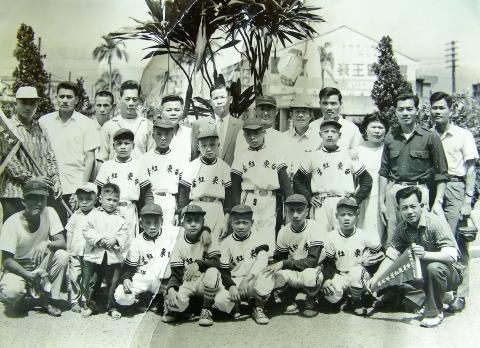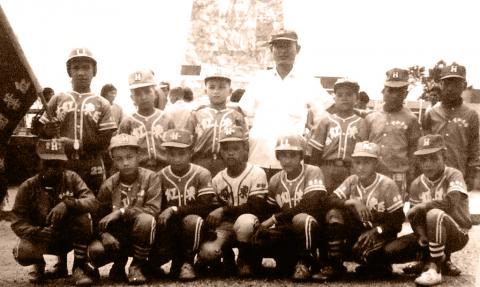Aug. 21 to Aug. 27
Chiu Sheng-teh (邱聖德) recalls protesting in anger when he heard a sports commentator say that the accomplishments in the 1960s of the Hongye Junior Baseball Team (紅葉少棒), made up of members from the Bunan Aboriginal people, were just an exaggerated legend that was sensationalized by the media and should not be celebrated.
Chiu’s father was a member of the 1968 team, which pretty much ignited Taiwan’s baseball craze, serving as a prelude to the glorious 1970s when Taiwanese teams dominated the international circuit.

Photo: Yang I-min, Taipei Times
But despite the team’s inspirational rags-to-success story, it seemed to always have its skeptics — and its fair share of controversy. In response, Chiu later published the study The Summer of 1968: A Study on Hongye’s Life History (1968年的夏天 - 紅葉少棒隊生命史的研究).
BASEBALL LEGEND
Let’s look at the legend first. It almost didn’t happen for the Hongye little league baseball team. Despite claiming first place at the Chiumao Cup (秋茂杯) in Tainan in March 1968, the team announced that it would not be able to make it to the National Youth Tournament in Taipei the following month because it lacked funding.

Photo: Chang Chun-wei, Taipei Times
Situated in an impoverished Aboriginal village in Taitung County, it is said that the team would often have to practice with “sticks as bats and stones as balls.” According to a news report from May 1968, the school only had 114 students and five staff, including the principal. Luckily, Hongye’s plight was widely reported in the media, and the donations poured in, enabling the team to participate. It eventually captured the championship by defeating a team from Chiayi 2-1.
The story does not stop here, as Hongye’s success earned it a match with a visiting Japanese all-star team. Up to this point, no Taiwanese youth team had defeated a youth team from Japan. On Aug. 25, however, after seven innings, Hongye emerged the winner with a 7-0 finish, and reportedly did not even allow a Japanese player past first base. Victory was sealed when Hongye scored two home runs in a row in the sixth inning. News reports show that bills of NT$10, NT$50 and NT$100 rained down from the crowd of 20,000 despite attempts by officials to stop the behavior.
Two days later, then-defense minister Chiang Ching-kuo (蔣經國) personally congratulated the team and promised that he would visit their village. In addition, the Ministry of Education announced that it would give the school NT$10,000 for sports equipment. The era of Taiwanese dominance of the diamond had just begun, which was a boost for the nation at a time when it was losing its international standing.

Photo: Wang Ing-ming, Taipei Times
Why would such a beautiful story have so many doubters?
THE DOUBTERS
First of all, there was the scandal that the team used older players from outside the school who competed under false names. As early as June 18, 1968, the United Daily News ran an article stating that 23 fans had reported the behavior to the Ministry of Education and the National Baseball Association.
Hongye denied the claims, and the association concluded that there was not enough evidence, and allowed the team to continue competing, adding that it had “strict” screening methods. Hongye principle Hu Hsueh-li (胡學禮) stated in a news conference that the accusations were made by jealous opponents.
Not much news was made of it over the following months, but on April 26,1969, coach Hu and the team’s manager were convicted and sentenced by the Taitung District Court for forgery of public documents. The United Daily News report said that they had falsified the ages of five players and also used players from outside the school who played under the names of several current players.
The final bit of controversy is that for whatever reason, the popular version of events became that Hongye beat the Japanese little league world champion Wakayama on that day. This version is perpetuated even to recent times, as the school celebrated the 40th anniversary of its victory against “Wakayama” in 2008.
Chiang Chieh-long (江杰龍) shows in the study The Rise of the Hongye Little League Baseball Team (台東紅葉少棒隊的崛起) that there was mass confusion in the media as to whom exactly Hongye would be playing, with each article stating something different or being ambiguous. In the end, the Wakayama version stuck.
Chiang’s argument, however, is that it could not have been the Wakayama team because they were competing in the Little League World Series in the US, which didn’t conclude until Aug. 24. The question is, was this confusion intentional to boost the team’s legend, or was it just sloppy reporting?

Oct. 27 to Nov. 2 Over a breakfast of soymilk and fried dough costing less than NT$400, seven officials and engineers agreed on a NT$400 million plan — unaware that it would mark the beginning of Taiwan’s semiconductor empire. It was a cold February morning in 1974. Gathered at the unassuming shop were Economics minister Sun Yun-hsuan (孫運璿), director-general of Transportation and Communications Kao Yu-shu (高玉樹), Industrial Technology Research Institute (ITRI) president Wang Chao-chen (王兆振), Telecommunications Laboratories director Kang Pao-huang (康寶煌), Executive Yuan secretary-general Fei Hua (費驊), director-general of Telecommunications Fang Hsien-chi (方賢齊) and Radio Corporation of America (RCA) Laboratories director Pan

The classic warmth of a good old-fashioned izakaya beckons you in, all cozy nooks and dark wood finishes, as tables order a third round and waiters sling tapas-sized bites and assorted — sometimes unidentifiable — skewered meats. But there’s a romantic hush about this Ximending (西門町) hotspot, with cocktails savored, plating elegant and never rushed and daters and diners lit by candlelight and chandelier. Each chair is mismatched and the assorted tables appear to be the fanciest picks from a nearby flea market. A naked sewing mannequin stands in a dimly lit corner, adorned with antique mirrors and draped foliage
The consensus on the Chinese Nationalist Party (KMT) chair race is that Cheng Li-wun (鄭麗文) ran a populist, ideological back-to-basics campaign and soundly defeated former Taipei mayor Hau Lung-bin (郝龍斌), the candidate backed by the big institutional players. Cheng tapped into a wave of popular enthusiasm within the KMT, while the institutional players’ get-out-the-vote abilities fell flat, suggesting their power has weakened significantly. Yet, a closer look at the race paints a more complicated picture, raising questions about some analysts’ conclusions, including my own. TURNOUT Here is a surprising statistic: Turnout was 130,678, or 39.46 percent of the 331,145 eligible party

The election of Cheng Li-wun (鄭麗文) as chair of the Chinese Nationalist Party (KMT) marked a triumphant return of pride in the “Chinese” in the party name. Cheng wants Taiwanese to be proud to call themselves Chinese again. The unambiguous winner was a return to the KMT ideology that formed in the early 2000s under then chairman Lien Chan (連戰) and president Ma Ying-jeou (馬英九) put into practice as far as he could, until ultimately thwarted by hundreds of thousands of protestors thronging the streets in what became known as the Sunflower movement in 2014. Cheng is an unambiguous Chinese ethnonationalist,